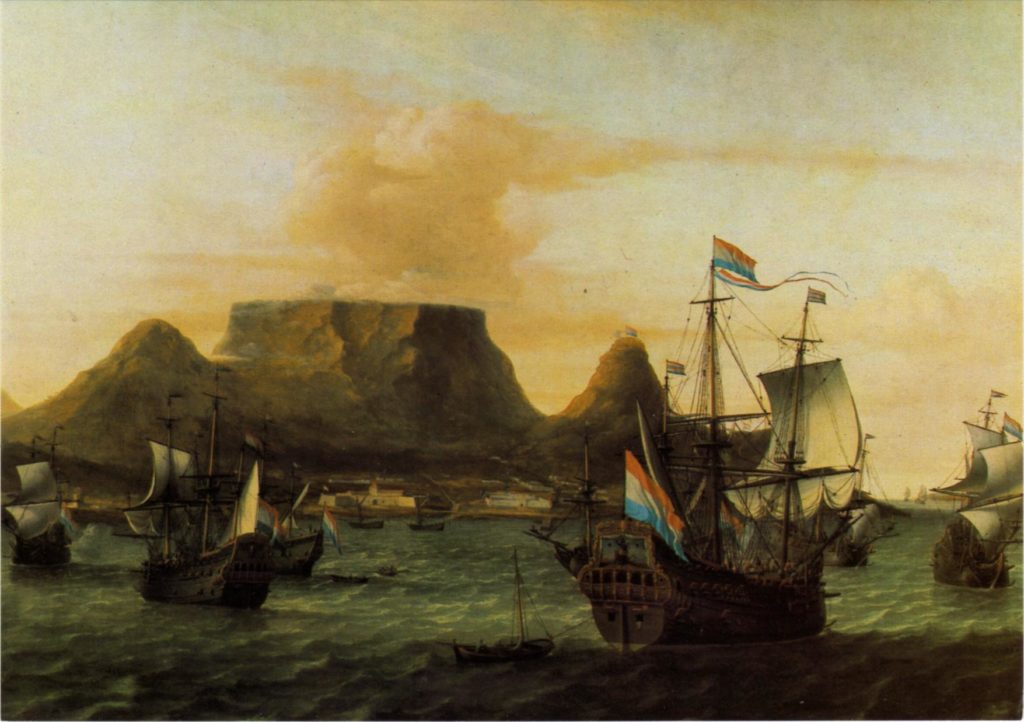Last updated on July 22nd, 2022 at 06:59 pm
The Flying Dutchman is one of the most famous ghost stories in the world, popular over the centuries for capturing the imaginations and nightmares of sailors, captains, and children, and featuring in many adaptations in books, television shows, and movies in recent decades.
However, what truth is there in such an iconic and legendary story? Where did the origins of the Flying Dutchman come from, and who were he and his crew? Why has this ship and legend survived the history books for centuries?
This article explores the true story behind many popular legends surrounding this mysterious sea monster known as The Flying Dutchman.

The Real Story Behind the Flying Dutchman
The Flying Dutchman legend first appeared in the mid-16th Century when sailors began recording strange voices they heard while at sea. These voices were said to be the disembodied spirits of those lost at sea.
According to tales, The Flying Dutchman was originally a part of the Dutch East India Company Fleet. These ships carried exotic silks, spices, and colors back to the Netherlands between the Dutch ports and the East Indies.
In 1641, the Dutchman’s Captain was Hendrick Van der Decken. The outward voyage was uneventful, but the return one was very different.
As Van der Decken returned to Amsterdam, trying to get home as soon as possible, he decided to take the ship through the fastest route, which led them through a channel known as the Cape of Good Hope, a piece of coastline that can be found at the very south-westerly point of South Africa. However, a terrible storm appeared and rocked the oceans at their core upon attempting the route. Terrified by nature, the crew begged for the captain to stop and turn back, fearful for their lives.
Now, this is where the story can get a little divisive. In earlier versions, Captain Van der Decken knew this would be a mistake and tried to turn the ship around, but he was unable to due to the high winds and stormy conditions.
In later versions of the story, Van der Decken downright refused to turn the ship around and continued into the night’s storm. Some versions claim the captain was drunk, whereas others claim he was just insane. Of course, it’s impossible to know the truth of the matter, especially so many years in the future, so we’ll leave it up to you to decide which you like best.
Regardless of the reason, the ship was now on a non-stop collision course with the storm, and the Flying Dutchman had no way of turning back. Of course, the crew weren’t happy and mutinied against the captain, desperately trying to seize control of the ship while attempting to turn it back around, but there was no escape. Finally, Van der Decken took matters into his own hands, killing the mutiny leader and throwing his body off the boat into the storm, once again sealing the crew’s fate, muttering ‘until doomsday’ under his breath in madness.
An angel reportedly appeared to the Captain and challenged his words as this unfolded. Van der Decken, defiant in his ways, uttered the words again, thus sealing the fate of himself, the ship, and the crew to sail the seas in this haunted way ‘until doomsday.
Other versions of this story sit between the years 1680 and 1729. No angel appeared in these versions; instead, the devil himself tricked the captain into sailing the oceans for eternity. However, Satan did give the captain a clause for him to break the curse. If he could find a woman and get her to fall in love with him while she remained faithful, he could free himself and the crew. Therefore, he was allowed to go on land and search for the answer every seven years.
Whichever version of the story you like the most, the fact remains that the Flying Dutchman one fateful day found itself heading towards a storm and never came out the other side. Since the storm, the ship has been described as sailing worldwide, usually hovering just above the waves or coming out of the water beneath the other ships that spot it. Therefore, any sighting of The Flying Dutchman signifies that impending doom is on the way.
Reported Sightings of the Flying Dutchman
Sailors who had experienced the strange voice of the Flying Dutchman, as reported by their fellow mariners, often wrote about their encounters with the ghost. The first published account of a sighting can be found in a 1790 work called “Travels in various parts of Europe, Asia, and Africa during a series of thirty years and upward”, written by John MacDonald. Yup, that’s a very catchy name for a book.
The reference was incredibly small, simply reading;
The weather was so stormy that the sailors said they saw the Flying Dutchman. The common story is that this Dutchman came to the Cape in distress of weather and wanted to get into harbour but could not get a pilot to conduct her and was lost and that ever since in very bad weather her vision appears.
The next known printed sighting of the Flying Dutchman was recorded by a George Barrington in his book, A Voyage to New South Wales in 1795, in chapter five, which read;
I had often heard of the superstition of sailors respecting apparitions and doom but had never given much credit to the report; it seems that some years since a Dutch man-of-war was lost off the Cape of Good Hope, and every soul on board perished; her consort weathered the gale, and arrived soon after at the Cape. Having refitted and returning to Europe, they were assailed by a violent tempest nearly in the same latitude. In the night watch, some of the people saw, or imagined they saw, a vessel standing for them under a press of sail, as though she would run them down: one in particular affirmed it was the ship that had foundered in the former gale, and that it must certainly be her, or the apparition of her; but on its clearing up, the object, a dark thick cloud, disappeared. Nothing could do away the idea of this phenomenon on the minds of the sailors, and, on their relating the circumstances when they arrived in port, the story spread like wild-fire, and the supposed phantom was called the Flying Dutchman. From the Dutch, the English seamen got the infatuation, and there are very few Indiamen, but what has some one on board, who pretends to have seen the apparition.
Of course, it’s important to remember that tales would have traveled by word of mouth back in those days, and books and writing were rare, so the sightings in this sense are minimal. However, that doesn’t mean that there aren’t more sightings, especially when you consider that sightings were still common, including the 19th and 20th Centuries.
Easily the most well-known sighting came from Prince George of Wales, who later became King George V. His sighting took place as he was on his three-year voyage as a teenager with his brother, Prince Albert Victor, in 1880. After their initial ship had sustained damage to the rudder, the group found themselves living on the HMS Inconstant.
Just before dawn on 11th July 1881, just off the coast of Australia, Prince George described the Flying Dutchman ‘crossing our bows’ around 4 a.m. The journal entry reads;
A strange red light as of a phantom ship all aglow, in the midst of which light the masts, spars and sails of a brig 200 yards distant stood out in strong relief as she came up on the port bow, where also the officer of the watch from the bridge clearly saw her, as did the quarterdeck midshipman, who was sent forward at once to the forecastle; but on arriving there was no vestige nor any sign whatever of any material ship was to be seen either near or right away to the horizon, the night being clear and the sea calm. Thirteen persons altogether saw her … At 10.45 a.m., the ordinary seaman who had this morning reported the Flying Dutchman fell from the foretopmast crosstrees on to the topgallant forecastle and was smashed to atoms.
So, is the Flying Dutchman Real?
The Flying Dutchman legend has been around for centuries, during which time it has been reported in many different versions. Though there is no concrete evidence to support the fact that The Flying Dutchman is a ghost, many people who have reported sightings of this sea monster have felt a sense of dread when seeing him.
It’s a terrifying idea, especially when you put yourself in the eyes of a sailor or crewmember. If you see something on the horizon or under the water coming towards you, perhaps out of fear, bad things start to happen. So it’s easy to see that these stories would feel very real in the moment.
The fact that the Flying Dutchman would attack and leave a boat empty, a ghost ship, entirely without a crew or evidence of them is suspicious. It’s true that if a boat was to find itself in a storm or facing a mutiny, it could render a ship completely without crew. But, if it survived, it would be a ship sailing empty, just waiting to be discovered, which would feed into the stories of the Flying Dutchman being real.
However, there are few reports of this, and as you can see from the sightings above, they were sightings of the ship being around other ships, so what gives?
Well, many factors could be involved. For example, suppose you were to look over the edge of your boat and see another boat coming up out of the water towards you. In that case, this could be anything from a trick of the light where the sailors see a reflection of the boat they’re on or even a shallow bit of water where the reflections become distorted. This would describe sailors looking into the water only to see a face looking back at them.
Of course, depending on where you are in the world, you could also see whales or larger fish under the water, which could create the image of something larger swimming below the boat. So there are clearly a lot of possible explanations, but then what about seeing a large boat floating above the water?
Well, there is a possible scientific explanation that could be relevant. The process is known as looming. This is an optical illusion based on light. When light rays hit the water, they are bent across various indices, refracting so that it creates an illusion between the sky and the horizon. It’s almost like putting a straight straw in a glass of water and seeing it refract at a different angle.
There are endless examples of looming in action and plenty of modern, clear photographs and videos existing that prove that this is the case, so back in the day, if you were to see a boat on the horizon floating above the water, sure you could think it was the Flying Dutchman, but it’s possible it was a boat looming. But, of course, the science wasn’t known at the time for sailors to be aware that this was the case.
Fact or fiction?
Cases like the Flying Dutchman are certainly interesting to read about and exciting to imagine being real, but it’s always hard to say whether they’re fact or fiction. Of course, science would say otherwise, and since there have been no confirmed sightings or evidence in the age of smartphones and video cameras, the chances are it’s just an old maritime tale that we’ll continue to enjoy through media, but then, on the other hand, you never know what could be lurking in the depths of the vast oceans that span this world.

